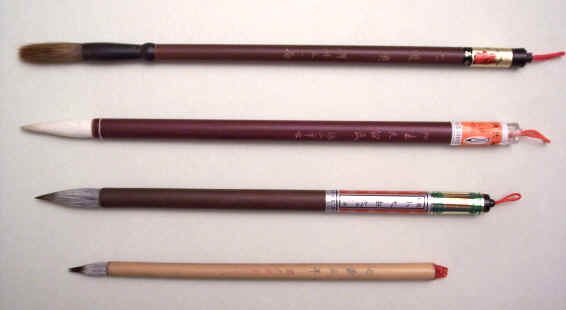
Principles of Chinese Calligraphy
Choosing the right brush is
one of the most critical steps for learning Chinese calligraphy at all levels. Since a lot of brush techniques, calligraphy styles, and theories are based on the kinds of brushes used, a thorough comprehension of this section is strongly
recommended.
Click here for a Chinese article about brushes: 毛筆基本常識
§1.1
- Selecting a Brush
Chinese calligraphy brushes are
categorized by the characteristics of their
hair; these fall into three categories: stiff, soft, and mixed. Within these general categories are many different brushes varying in size, shape,
length of
tip, and percentages of different animal hair - each made for many different purposes.
Brushes used for
Chinese Brush Painting and Chinese calligraphy
are somewhat different based on their specific uses. Since there are many ways to categorize brushes,
they are classified here primarily from the perspectives of practice.
A Chinese calligraphy brush can generally be categorized by:
1. Kinds of hair used
2. Sizes (lengths) of hair
3. Proportion of length to diameter of the brush's hair
There are four major categories of brushes for Chinese calligraphy based on materials used.
1. Hard Brushes - usually Weasel Hair Brush “pronounced as Lun Hao ( 狼毫 )," more resilient and stiff
2. Soft Brushes - usually Goat Hair Brush “pronounced as Yeung Hao ( 羊毫 ),” softer than weasel hair
3. Combination Brushes “pronounced as Jian Hao ( 兼毫 )” – generally combine weasel and goat hair or other hair in various percentages
Weasel Hair Brush, Goat Hair Brush, and two Combination Brushes
4.
Brushes made of other types of hair (rat, rabbit, deer, horse, bear, badger, rooster, baby hair and so on).
Brushes made of baby hair
( 胎毛筆 ) are great gifts for lifetime memory and are very popular in Asian families.

Different Types of Brushes & Books on Brushology
A Weasel Hair Brush ( 狼毫 ) is stiff and robust. Weasel Hair Brushes are mistakenly translated as Wolf Hair Brushes in many English resources as the Chinese people usually do not distinguish a wolf ( 野狼 ) from a weasel ( 黃鼠狼 ) in the spoken Chinese language. This type of brushes are made from the hair of the weasel's tails while a wolf's hair will be too stiff to write.
|
Literally: 黃鼠狼 (weasel) = yellow tail wolf, 野狼 = wild wolf, 狼狗 (wolf dog): a big dog that looks like a wolf. Many English books have used the incorrect translation and some are using "weasel hair brushes" correctly. I feel grateful to Mr. Thomas Yu, a renowned Chinese calligraphy scholar in Dallas, for corrections regarding this issue.
Hair of the weasel's tails used to make brushes
|
A
Weasel Hair Brush holds less amount of ink than a Goat Hair Brush. If the Weasel Hair Brush is small, it is suitable for practicing small characters (
小楷 ) within the size of a square inch. Weasel Hair Brushes are also good for practicing Hsin and Tsao Styles in
faster writing speeds. Generally, Chinese calligraphers don’t use Weasel Hair Brush for Zuan and Li Styles because it’s not suitable for the beginning of strokes
( 起筆
) in those two styles; however, this is not absolute. In consideration of many
different sizes and characteristics of brushes, it is not fair to state that stiff-hair brushes are easier for a beginner to control while soft-hair brushes allow for more flexibility and special effects. All these take into account the brush material, sizes as well as the style and size of the calligraphy strokes, and most importantly, the level of the calligrapher's
or the writer's technique.
Jian Hao, a combination of stiff and soft hair, is made of different animal hair. The ratio of hair may vary depending on the types of brushes produced. Most Jian Hao Brushes are made of weasel and goat (or rabbit) hair. A Jian Hao Brush may be used for a wide range of painting and calligraphic styles. It's somewhat like an all-purpose brush with less specialty and uniqueness.

Various Possibilities of a Combination Brush
|
A brushstore ( 筆莊 ) is different from a regular bookstore. Brushstores in Asian countries sell writing and painting brushes, calligraphy models and painting albums, seal chops, reference books and dictionaries ... specifically for the practice of Chinese Brush Arts. The making of a good brush is very, very technical and usually takes from even one to several days. While average or low quality brushes are sold in larger quantities than real good brushes in the market due to business perspectives such as customers' price preferences, manufactures' labor rates, or the brushstore owners' concern, choosing good brushes is not necessarily related to the price tags but mostly related to the brushstores' reputations in many cities and towns of China and Taiwan. A reputable brushstore with all purpose brushes
Brushstores in Taiwan
Testing Brushes with Water Writing Paper
Most brushstores in Asia may let the customers try writing on Water Writing Paper ( 水書紙, 水寫紙, commonly called magic paper) or even with ink. Some of them even have refund, exchange, or trade-in policies. Brushstores with good reputations do not necessarily sell at higher prices and are mostly preferred by many Chinese calligraphy teachers from whom students can directly purchase brushes. Brushstores and makers of average or low quality brushes usually survive by marketing... Many times a beginner or those who have not studied brush principles as stated in many Chinese calligraphy theory books or on this WebPage may have experiences of buying a brush with falling hair or even cracked handles or fallen "brush heads." Then they go back to the brushstores to negotiate for exchange or refund ... If the brush makers make very high quality brushes with enough labor and carefully selected animal hair, the prices will not necessarily be acceptable by the brushstore owners or average customers. If the brushstore owners or customers demand a lower price range, the brush makers will not spend a whole day just to make a fine brush... These dilemmas have increased in severity due to the rising cost of living in China and Taiwan and the perspectives of businessmen or brush makers with limited artistic insight. (The brushes made in ancient China, especially used by master calligraphers, were extremely delicate and fine in quality and function.) These "triple dilemmas" may be avoided by the consumers if they have understood the principles as provided here. There are actually good brushes that are sold at very reasonable or even inexpensive prices in the market. Using a bad brush will definitely discourage anyone (including a beginner or an experienced calligrapher) from the enjoyment of writing and making progresses no matter how talented one is! It will be totally useless if one cannot get a good brush even though one's teacher, guidance, experience, talent, insight, persistence, and so on are extremely superb. It's advisable that a publisher or a wholesaler that includes a Four Treasure kit with their products to source reliable brush makers, otherwise consumers will most likely be discouraged from their first trials without ever understanding the real reasons instead of their true talents. This, in turn, will also decrease the brush maker's and publisher's profits for the long run. If most beginners of Chinese calligraphy can understand the criteria of selecting and buying good brushes with or without the aids of experienced calligraphers, the enjoyment of writing and making progress will be greatly enhanced. This, in turn, will help reliable brush makers to more fairly price their products and other brush makers to improve their quality. If a beginner or practitioner finds his/her result of making strokes is not desirable, find the "true reasons" instead of making conclusions like "maybe I am not really talented..." In my experiences, I have had practiced certain strokes several million times since my childhood till now. And, of course, I have bought a lot of brushes that I am not satisfied with. (What am I going to do with those average or lousy brushes?) I also have written innumerous unsatisfied strokes even with good brushes... Expectation of immediate results and ego are definitely no guarantee but usually the stumbling blocks in making fine strokes. Methodologies and persistence are more promising factors.
|
|
Occasionally I receive feedbacks or questions regarding the qualities of brushes. I have paraphrased a letter as follows: Dear Joshua Hough, Do you sell the calligraphy brushes that you mentioned
on your website? Frankly, I really do not know how to pick the "best" brush. I can say that I am a novice. Very true that a good brush does improve a beginner's confidence and to assist a beginner to keep on practising. The opposite is also true. Beginners will give up quickly with a lousy brush believing that they are not talented and simply it is our human instinct to give up quickly and move on to another new interest. I started Chinese
calligraphy two years ago but I gave up immediately! Yesterday, I responded to a local advertisement, a
Chinese came here to teach Chinese calligraphy. I went there for a free trial class and I did notice something different. Not only the strokes he teaches are slightly simpler but the brush that he uses is much better than the one I bought
two years ago. That is when the "resilience" comes in, he mentions it too. No wonder the brush I bought does not spring
back when I press it down. Similar things were happening to my cousins learning piano and violin. One of my cousins who learned violin gave up quickly and tuned to piano. He stated that it took longer time for him to produce the right sound and pitch on the violin than on the piano. And he said he would save his time playing the piano rather than a violin. Then a relative who had played in a local orchestra came to visit and shared with him more methods on violin. My cousin tried again on the violin and agreed with a conclusion that if he just tried an instrument like violin for fun, he just picked up the wrong one. He could have tried a flute, a piano, or something that has a scale marked on the instrument. Thank you. My
typical reply would be something like this: Hi
Chris: Thank you for your feedback and words. My students occasionally ask me to separate Chinese calligraphy brushes and Chinese painting brushes for them so they can use the "right" ones either in calligraphy or painting. I try to avoid answers that involve "dichotomy" that separates brushes into "good or bad" groups, "calligraphy or painting" groups, "expensive or cheap" groups, and the like because there is no perfect answer that fits everyone and different styles or genres of calligraphy and painting. For this, I have a "Ten Fingers" parable. Each of our ten fingers has advantages and disadvantages when doing something. Beethoven Hammerklavier Sonata is one of the most difficult piano pieces ever written, especially the fourth movement as a fugue. Since every piano player has different sizes and shapes of hands and various kinds of sitting positions, we cannot simply stick to the fingerings as edited or suggested by Eugene d'Albert, Artur Schnabel, or other Beethoven specialists. In overcoming the technical difficulties and interpreting the music faithfully, we may need to change some fingerings as necessary to serve the music. A pianist who is willing to overcome this difficult piece may need to consult other pianists how they overcome it and how long it takes for them. Sometimes my students would question about the brushes and their talents. My solutions are to ask a bystander (a visitor or any unrelated person nearby) to write or paint something to prove it's not related to the brushes' quality or the students' talents but it is more related to one' access of information or instructions (the methods, understanding and application and methods, trying different combinations of forces, directions, pressures, positions, and angles) and one's attitudes. Sooner or later, they agree it's not necessarily related to their talents or brushes. Wish you the best for your enjoyment of art. Sincerely, Joshua
|
The best and most reliable places to get quality and "conforming" Chinese calligraphy brushes are reputable brushstores or Chinese bookstores, especially if the owners practice Chinese calligraphy or brush painting. The prices do not necessarily guarantee the quality. (Sometimes a cheaper brush can be excellent!) Not all brushes are made "equal" even if they are made with the same model number by the same artisan for the same batch. Frankly speaking, many American art suppliers as well as some websites sell "non-conforming" brushes not suitable for Chinese calligraphy at all, even though they are imported from China, Taiwan, or Japan. For manufacturers or importers to supply "conforming" Chinese calligraphy brushes, at least they have to know the "Four Virtues of Brushes" as explained in § 1.3 which are also widely known among many practitioners. Sometimes many beginners become frustrated very soon when they cannot do a fine brushstroke as they doubt their artistic talents and how much more time will be needed to achieve a certain level. The problems are usually the type of brushes they bought and (or) lack of understanding of the basic principles of holding and operating a brush or other technical factors. These situations are also prevalent in Asian countries. As experienced teachers or calligraphers point out the reasons (usually the wrong type of brushes), most beginners often make improvements with the right type of brushes in a shorter time.
The Famous Li Fushou brushes - One of the Top Brands in China
§
1.2 - Different
Sizes of Brushes
Brushes have many sizes. Some are as large as brooms and some are as small as needles. As we read more in the “Theories" and "Principles” sections, we should know that we only use a small portion of the brush's tip to write. So a bigger brush is generally preferred over a smaller one for a specific calligraphy style and/or size. A small brush should never be used for large-scale calligraphy ( 大楷 ).
§
1.3 - The
Four Virtues of Brushes
The criteria to choose a good writing brush are usually called the "Four Virtues of Brushes." The four virtues of a brush refer to a good brush being “pointy, even, round, and resilient.” ( 尖齊圓健 Pinyin: jian1 qi2 yuan2 jian4)
1. "Pointy" means the brush tip should be as pointed ( 尖 pronounced as Jian 1) as an awl. It requires the hair on the brush should always form a defined and symmetrical tip.
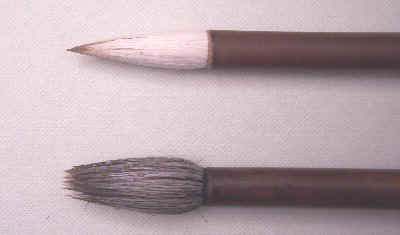
An
unused brush has pointedness while an old one may eventually lose it’s
pointedness.
2. "Evenness" ( 齊 pronounced as Chee 2) means that when we spread a brush by holding it down, the hair are even and not scattered. Some sources say when the brush is dry, the hair should be level and even, tapering to exactly the same length. This kind of statement is based on when the brush is not in use and is dry. To state more correctly, we judge a brush's quality when it is in motion and wet with ink instead of when it is still. For better viewing and easier observation, the following pictures show the qualities when the brushes are dry.
|
The brush on the top is more even than the one on the bottom. Only a tiny difference can be observed.
|
Without evenness when pressed
|
With evenness when pressed
|
If, for some reasons, the brush
hairs are not even, the "evenness" can be improved by combing the hair with a toothbrush gently in a linear
direction. This may
require some experience. Otherwise, it may make the brush even more worse.
3. "Roundness" ( 圓 pronounced as Yuan
2) means the brush tip must be in the center of the circle when we
check this criteria by turning the brush around. As shown in
the left picture, as we rotate the bamboo handle for 360 degrees, the tip should always in the center of the circle and the circle should be perfectly circular in shape. This also requires
that the body of the brush formed by the
hair should be round and plump.
|
A brush with roundness |
A brush without roundness |
4. "Resilience" or "Strength" ( 健 pronounced as Jian 4) means the tip of brush hair is flexible or elastic. Stated in another way, a good brush should have hair that are springy and resilient and thus can "sprint or dance on paper" during writing. This requires the brush to have a good "spine" or "waist". The "waist" is the root area of the brush hair near the handle. When the brush is either wet or dry, the brush should retain its shape when being pressed down on paper. For a brush to be strong and resilient, it must contain enough number of hair to be solid. Many brushes sold in the market today fail to meet the standard of being "solid.” A brush that is solid is considered being strong. A well-made calligraphy brush must be solid and firm for its hair. The total number of hair used in each brush must be abundant and cannot be reduced to save production costs, time, and labor. Sometimes even if we go to a calligraphy specialty store ("brushstore"), many of their brushes are not firm. Since a new brush is usually coated with glue (or alum) on the hair, we will not be able to test the solidness of the hair even after we have examined according to the criteria of “pointedness, evenness, and roundness.”
Suppose we make two bundles of hay with same diameters and put horse gears on them. The one with more hay will be strong and solid and can uphold; the one with less hay will be weak and collapse. Similar to the latter case, an unsolid brush will collapse at the tip of hair when we press and write on the paper. Thus, the total number of hair used to make a brush is very, very important. Unfortunately, many brushes sold today fail to meet this critical requirement. This makes it not advisable to buy a Chinese calligraphy brush without testing it by yourself, unless you are very, very experienced or lucky or the brand and brushtores are very trustworthy.
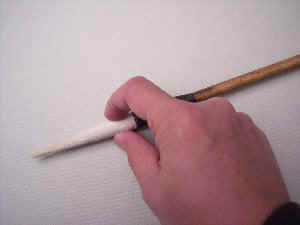
Squeeze the root ("waist") of hair to test solidness
Before we buy a brush, we better test the most crucial criterion of “strength (solidness).” If we forcefully press the root part of the brush as shown above, it is considered strong and solid enough if we cannot squeeze it. But if it is hollow or empty, it will be squeezed easily and this means the number of hair used to make that brush is not sufficient. (Be sure not to over-squeeze the brush in stores because it may make troubles for the owner!) The brush makers usually do this to save costs and labor at the sacrifice of quality. Sometimes this is the most difficult criterion to judge by the “Four Virtues” because manufactures can put extra glue to make it feel tight and strong.
The "waist" and the tip are the most crucial parts of a brush. If it is not strong, the brush is totally useless. Suppose a warrior has strong muscles in his arms and legs, he has no fighting ability at all if his spine or waist got hurt.
Many brushstores in Asia let customers soak the brushes until they become soft and ready. Then they let the customers dip with water (not ink) to test on Water Writing Paper. This gives us a rough feeling about how we are satisfied with that specific brush. If we feel it is good, we buy it. Otherwise, they can recoat the brush with plant or vegetable glue. This is still not a reliable testing because the densities and characteristics of water and ink are completely different. Sometimes when we start writing with a new brush at home, we become disappointed. The brush just does not work in the same way as we have tested in the store!
Another point besides the "Four Virtues" to emphasize is to choose a brush with straight handle. Most brush handles are made of bamboo. They may also be made of ceramic,
jade, horns, and etc. Brush handles should always be perfectly straight except those made of
horns or special types of materials. Since bamboo handles are not naturally straight, they are usually heated to be straight. So it's necessary to examine the handle to be perfectly straight from different angles before purchase. A straight handle and straight
hair are closely related to the Center Tip Theory (or Principle). If either is bent or not perfectly straight, the basic principle in writing Chinese calligraphy
may not be observed.
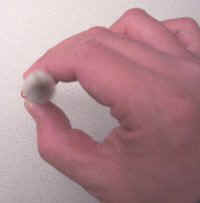
Brush tip in the center and a perfectly straight bamboo handle
As we become more knowledgeable in Chinese calligraphy principles and theories, we are more likely to pick up a right brush that does meet our standards.
§
1.4 - Regular
Brush vs. Long-Haired Brush (
長鋒 )
There is another way to categorize brushes according to the ratio of length and diameter of their
hair.
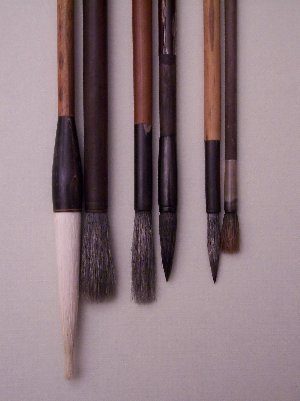
Each
pair of brushes shown has about the same diameter. The left ones have longer hair
and they are called Long-Haired Brush “pronounced as Tsung Fong Mao Bi 長鋒毛筆
”.
The right ones are just regular and common. Regular brushes are used by most
students and calligraphers and they are a lot easier to control.
A
Long-Haired Brush is much more difficult to control but it generates more
internal strength. It's more ideal to use Long-Haired Brushes for Seal Style,
Clerical Style, and even Walking and Running Styles.
Beginners or laymen may regard this kind of brush beyond control and
comprehension. Some self-proclaimed calligraphers may regard it as ridiculous and inoperable. Only Chinese calligraphers with
deeper foundation and higher levels will mostly choose Long-Haired Brushes over
regular ones. The value of Long-Haired Brushes is closely related to most
calligraphy theories, and almost all of those theories can be summarized in the Center
Tip Theory ( 中鋒理論
)
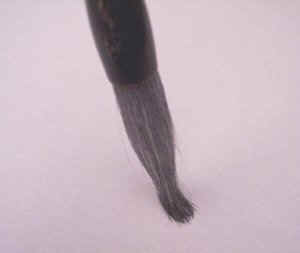
Using only a smaller portion of the tip of a Long-Haired Brush to write
The major assertion of the Center Tip Theory is to use a strong and solid Long-Haired Brush
(or a regular brush) and use only a tiny portion of the tip to write. Except for the tip used for writing, the major portion of the
hair can never be bent. (The soaking process to prepare a new brush requires the whole brush to be submerged with water, not just the tip or 1/3, 2/3 or ½ as mentioned by most Chinese calligraphy teachers or books. The whole hair must be submerged and softened during the soaking
process to provide the power according to the Center Tip Theory.)
Click to read a Chinese article about choosing a brush: 筆性與書家好尚
§
1.5 - Preparation
of A New Brush
A new brush usually has glue coating that must be removed by immersing the brush in warm water. Hot or cold water may compromise the shape and molecular structure of hair and the outcome will not be reversible! So soaking a new brush before use is as important as choosing a good brush.
Do not try to remove the glue by force. Soak until all
hair are fluffed out and softened. Wait very, very patiently because the appropriate preparation determines the destiny and optimal function of the brush. Soaking a new brush is just like a "baptism" and opens a new life for the brush. When soaking a new brush in a cup of water, the brush
hair must remain perpendicular to the ground during the entire process. This may take from a few minutes up to one hour depending on the size of
hair and the amount of glue. We may hang the brush's loop in a hook of a
brush hanger instead of holding it by hands for a long time.
|
Keep the brush vertical while soaking |
A fully soaked brush (note) |
Note: However, some brush handles are made of very thin and fragile bamboo sticks without a plastic connection between the handle and the brush hair. If we soak the brush hair too long in the water, the bamboo may crack due to the swollen hair. In this situation, it's recommended to soak up to 80% or 90% of the brush hair to prevent the cracks.
The soaking process to prepare a new brush requires the whole brush to be submerged with water, not just the tip or 1/3, 2/3, ½ as mentioned by most Chinese calligraphy teachers, students, or textbooks. The whole hair (or up to 90% per above note) must be submerged and softened, not just part of it.
|
The glue on brushes for writing small-scale characters should be removed from two fifths of the length of the hair. The glue on brushes for writing medium-scale characters should be removed from half the length of the hair, and the glue on brushes for writing large-scale characters should be removed from two thirds of the length of the hair. It is not advisable to remove all the glue from the brush. If it is removed entirely, the brush will not have the required force or vigor and a "fully-soaked" brush will be short-lived... How much glue should be removed just depends on the convenience of the user.
|
For those statements like the above, their reasoning is based on ease and convenience, not theory and foundation for long-term progress. For laymen they can be the right choice. For serious students and insightful calligraphers, the statement “If it is removed entirely, the brush will not have the required force or rigor” is wrong. The internal force of the brush during writing is generated by the calligrapher rather than by the brush itself. For those who have started from the easy way, their progresses and rewards are confined. For those who have struggled for the right way and the truth, the progress will be immeasurable.
Interestingly, Chinese Brush Painting masters and practitioners use the whole brush hair to create different textures, effects, and even simple dots in various shapes and sizes. They never complain that a full-soaked brush will lose vigor or be short-lived. From the very first moment, a student of Chinese Brush Painting gets used to a full-soaked brush and does not worry about the reduced vigor or life in painting objects. (The practitioners of Chinese calligraphy outnumber those of Chinese Brush Painting throughout the Chinese history, with a even lower percentage involved in carving seals.)
When I teach children or Westerns Chinese calligraphy, I prepare the fully soak brushes before their first classes in order to save more time for instructions and demonstrations. No one has ever complained the brushes are too soft or wimpy. However, during my public events, some people with prior experience in Chinese calligraphy borrow and try my brush and they ask: "Do you have another good brush?"
|
|
For those who abide by the popular and incorrect instructions, their logic is easy to follow and apprehended by the public. Let’s first compare two brushes of equal length in handles (
筆桿 ) but with different lengths of hair. Say, the first brush has
hair of two inches and the second one just one inch. If we soak the first brush for ½ and completely soak the second brush, what is the difference? The first brush will have just one inch long
hair and it does not make it different from the second brush except for the
diameter of the
hair. Let’s also compare two boxers. The first boxer trains the same amount of weight lifting as the second one does and they both punch the same bag with the same number of repetitions. However, the second boxer also trains his waist power and leg strength by doing extra sit-ups, jumping, and footwork. Then who will have better endurance and skill?
After we soak the whole brush, we only use a small portion of the hair's tip to write. The so-called "unused" portion serves to be backup or reserve of power. (To be more exact, the unmoved portion during writing serves to be reserve of strength and is used as a medium or channel to transfer mental power and internal force which is referred as “Jing Dao 勁道 (strength, power)” by most Chinese calligraphers. Without Jing Dao in one’s writing, a Chinese calligraphy work will look weak.) According to Chinese calligraphy theorists and internal martial artists, softness will also generate power. A Chinese calligraphy term “Ruan Ze Chiu 軟則遒 ” means that the soft (“pronounced as Ruan”) and long brush hair will generate enormous power (“Chiu 遒勁 ”) to go through the paper. (“Ze 則 ” here means “will be.”) This theory was common among ancient calligraphers and can be very easily understood and demonstrated by Chinese internal martial artists. In Chinese Kung Fu, a spear does not have a completely stiff rod, a staff can be solid and stiff or softer (not completely stiff), and a soft and fast whip may not be made up of steel chains.
To help understand this theory, let’s read the following examples. If we try to hold a strong man to stand up, we don’t need too much force. But if we are helping a weak man from falling down, we need more force to sustain him and naturally most of our force will be gathered around our wrists and eventually fingers. For helping either a strong or weak man, let's have two choices. First we let a kid with shorter arms to help the falling man. Or we can let a big man with longer and stronger limbs to help the falling man. Which will be doing better? (For more details, please refer to a theory by Liang Tung-Shu 梁同書 in the Ching Dynasty.) Another parable I would like to use is about the muscle textures of a mule and a tiger. A mule’s muscles look hard and tight while a tiger’s muscles look softer, relaxed, and firm. Which has better mobility and fighting skill?
There are many examples in Nature and physics to support the principle that we should utilize full hair of a brush rather than be confined by part of it.

A completely soaked brush with only the tip portion operating
§ 1.6 - Maintenance of Brushes
The brushes must be washed with clean and warm water after use.
Using a Cap Instead of Washing
Most brushes today come with plastic shield caps that can be put on to prevent the
hair from getting dry. Some say if we wash the brushes too often the hair will have shorter life. So they would rather use caps after each use. The next time when they write, they take off the cap and the
hair are still moist. But if they leave the brushes unused too long, say one week, the
hair get dried and become very stiff with ink residue
difficult to wash away. Using a cap after each practice session is more suitable in Asian countries where they have more humidity. In drier areas and countries it is not recommended. If the ink residue accumulates inside the
hair or on the
ink stone, it will hinder the brush motion to certain extent and limit our progress. Try to use clean brush, ink, and ink
stone. This is not mandatory and it depends on one’s preference and convenience. However,
for beginners, it is always best to practice with clean brush, ink, and ink
stone each time.
Most bottled ink contains preservative that protects the hair but also erodes the hair if we use caps and don’t wash after a long time. If the cap is on and the brush is not reused for a long time, the preservative will erode the hair. If we put on the cap in the morning and practice again at night, the preservative won’t do much damage to brush hair. Each time we put on a cap, we need to squeeze extra water or moist with a napkin. Then put on a thin layer of ink on the surface of hair to keep the brush hair moist for storage. If we don’t squeeze out the water, the hair will smell funky soon.
Wash Each Time After Use (Recommended)
Wash the brush gently with warm water and make sure no ink residue remains in the
hair. Then gently groom the hair with fingers and make it look like the following picture with
hair's tip in the center. Be sure to squeeze out excess water before doing this. The brush
must be hung up vertically with the tip facing downward. Do not place the brush horizontally or randomly after wash.

The more often we wash the brush, the easier for cleaning and the shorter time required for each wash. If the ink accumulates inside the hair, soak the brush again like we treat a new one.
|
Brushes properly hanging |
Tips facing upward not recommended |
Travel with Brushes
If we ever need to transport brushes during travel, keep them dry before wrapping them in a bamboo roll and secure them in a firm box. A bamboo roll is available in calligraphy specialty stores. It's similar to a roll to make sushi. A sushi roll is smaller and may
also be used to wrap brushes.
§
1.7 - How About If I Bought
a Bad Brush
Choosing the right brush is the most critical step for a beginner to learn Chinese calligraphy. Sometimes a beginner may have bought a bad brush due to lack of experience or not understanding the above-mentioned points. Chances are that when a beginner starts, the brush just works awkwardly. Usually the brush just splits at the tip or collapses at the root near the handle. It might be that the beginner has not accumulated enough skill or the brush is really a lousy one, or both. Just like learning to ride a bike, everyone falls at least once or twice. So we do not have to be disappointed or give up. We may ask someone with more experiences to help us choose a good brush.
I would recommend that a beginner to keep every brush he or she has bought, including the unsatisfactory ones. Maybe later when the beginner has made more progress, he or she may realize that the brush is not that annoying. Sometimes if we treat an average brush with the right procedures (including washing, drying, handing, or combing), that brush may eventually meet our expectation.